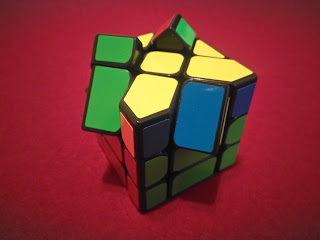Fisher Cube
The Fisher cube was created by Tony Fisher in the 1980s. If this was not the first shape modification of the cube, it was one of the first. It is not a bad first puzzle to try, if you want to play with something a little different from a standard 3x3x3.
On the U- and D-faces the corners behave like edges and vice versa. On the E-layer, the edges behave like centres and vice versa.
Solving the Fisher Cube
Solving a Fisher Cube is not a whole lot different from solving a normal cube. After getting used to the configuration the only additional complication is ensuring the pieces that behave like centres are orientated correctly.
When scrambled, the puzzle shape shifts into a chaotic shape.
Step 1: White Cross
Intuitive. The trick here is to align the pieces that behave like centres on the E-layer.
Step 2: First Two Layers (F2L)
Normal F2L techniques work here. If anything it is slightly easier than on a standard 3x3x3 because the pieces that behave like edges on the E-layer have no orientation.
Step 3: Orientate Yellow Edges
I this stage I orientate the final layer-edges. I leave permuting them until later. I find the puzzle easier to handle with the edges facing the right way.
There is the additional complication of a possible odd case parity where there could be one or three of the edges rotated. This is very easy to fix: just orientate one of them with an E-layer edge.
Step 4: Solve Corners
I then do things the old fashioned way of permuting the corners first, before rotating them. I don't know which advanced algorithms affect the centres on the E-layer and which don't. I should much rather keep things simple and use basic algorithms that I know are super cube safe.








No comments:
Post a Comment